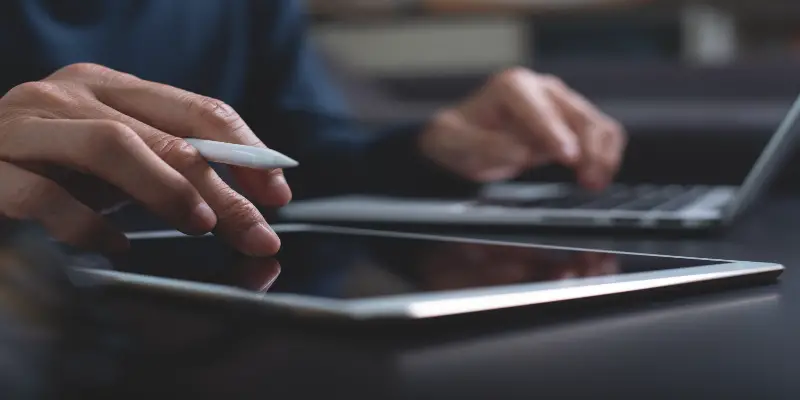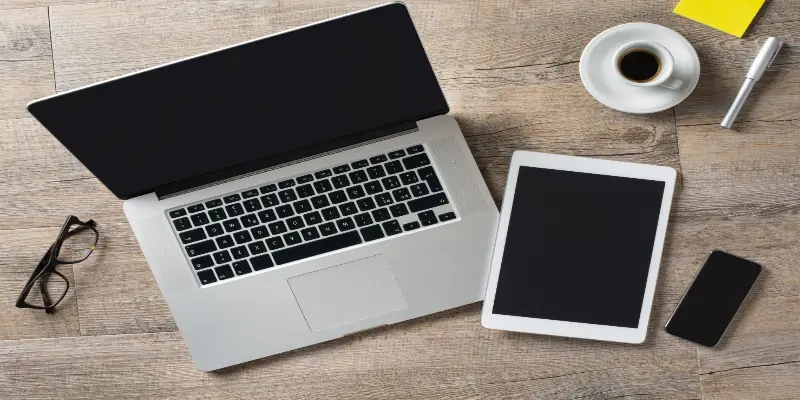Disclaimer: This post may contain affiliate links, meaning we get a small commission if you make a purchase through our links, at no cost to you. For more information, please visit our Disclaimer Page.
Laptops and iPads are, without a doubt, convenient devices. These devices help bring the world to your fingertips. You might be reading this article using either device. Nonetheless, you may sometimes have to choose between a laptop and an iPad. So, you have to consider, laptop vs iPad which is better for you?
Both a laptop and iPad come with their benefits. Therefore, you must consider your needs. Generally, laptops are favored for their powerful processors – allowing them to work faster and to multitask. iPads are ideal for those who want portability.
This post below breaks down in detail the key features of the two devices. It also outlines their similarities and differences. This is all to help you get an in-depth laptop vs iPad comparison so you can decide which device is better for you.
The article answers questions such as – why should you opt for one device over the other? And, why one device works better than the other for you?
Table of Contents
Difference Between An iPad And A Laptop
Laptops and iPads will almost entirely let you do the same thing. Using either device, you can browse the web, access apps, and even, do your work using software such as MS Word or Excel.
However, the two devices still hold vast differences. These devices hold differences in their size, storage space, performance, and many more. To effectively uncover their differences, you want to look at their key features. These include;
Size
This is perhaps the first difference you will notice between the two devices. iPads are smaller than laptops. Because of their smaller sizes, iPads also weigh less than laptops. An iPad weighs about 2 to 3 lbs whilst a laptop weighs a minimum of about 5 lbs.
However, the size difference between the two devices brings its own benefits too. Being small and lightweight, iPads are compact and portable. This makes them ideal for people who are always on the go or travel a lot.
All you have to do is simply toss it in your backpack or book bag.
Laptops tend to be bigger because of both their physical and performance components. Integrating a keyboard, cursor, and even a larger screen, a laptop has to be large-sized.
It also has more internal components to add to its size and weight. But, its exterior and internal components make it powerful. Due to its high powered build, a laptop needs a higher cooling capacity to meet its needs.
The higher cooling capacity, in turn, further increases its size too. But, this comes with the benefit of giving you a powerful processing ability to execute more tasks much faster.
In the market, you will find iPads that measure between 7.9 inches and 12.9 inches in screen size. Laptops on the other end measure between 11 inches and 17 inches.
Design
iPads feature a touch screen interface design which makes them difficult to use if you type a lot. A touch screen interface works best for those who want to navigate the device.
For example, if you use the device for social media or to watch videos, a keyboard really isn’t necessary.
Sure, an iPad offers an on-screen keyboard option. But, this is not close to what you will get when you use full sized laptop keyboards. After all, even with an on-screen keyboard, you will still have to deal with the smaller, restrictive iPad size.
Investing in external keyboards such as bluetooth ones means more spending. Plus, with extra gadgets, the iPad eventually loses its portability advantage.
Batteries
iPads and laptops feature a different battery design. iPads integrate an internal lithium-ion rechargeable battery. When paired with their low power requirements, iPad batteries offer maximum efficiency.
An iPad doesn’t feature many internal components, but, its battery takes up most of its space. This gives them a much longer battery life.
You can use an iPad for about 8 to 10 hours before it requires recharging. A laptop on the other hand features an even bigger battery capacity.
However, it takes up less space – sharing it with more internal components. With a larger battery capacity, you can do more with your laptop.
But, the consequence is that the battery’s life doesn’t last that long. Typically, you can use your laptop for about 4 to 5hours before it needs recharging.
Storage
Everything about tablets, such as iPads involves low cost design. The low cost design is what helps keep their costs down.
Thus, iPads have significantly smaller storage space due to their smaller functioning capacity. iPads use a solid-state storage memory to help store their data and program.
So, in general, an iPad will have storage space between 16 and 128 GB. Laptops integrate hard disk drives which give them a larger storage capacity.
Depending on the design and budget, laptops offer storage space between 500 GB and 1TB.
Yet, both iPads and laptops offer alternatives for extra storage space. They have added features such as their USB ports and microSD card slots.
Performance
As mentioned above, laptops integrate several internal components to improve their processing. The result? Higher capacity, quicker functioning, and better multitasking. Using a laptop makes more demanding tasks such as HD graphics and even multi-app usage easy.
iPads, on the other hand perform better with more basic tasks. You can use them for web browsing, social media, or even music or movie streaming.
The processing ability of both laptops and iPads affect their software running. For example, a laptop and iPad may have the same windows software.
However, the functionality of the software on each device will slightly vary. Due to its smaller capacity, the windows software will run slower on iPads. Similarly, iPads and laptops run iOS apps.
But, comparing their performance, you will notice that iPads have some features cut out to cater to their smaller capacity.
Cost
Cost-wise, laptops, and iPads may overlap. But, you can still find cheaper iPads and more expensive laptops. You can find budget or used iPads costing as low as $100 and some that extend to about $1000 new.
Laptops on the other hand are available for around $300 to $400 or less for budget options. More expensive options run up to $3000.
Pros And Cons Of Laptops And iPads
Like other man-made tools, laptops and iPads have their benefits and limitations. Below are some of the pros and cons for each device;
iPad Pros
- Flexible design – they are a cross between a smartphone and a laptop
- Lightweight and portable – travel friendly
- Longer battery life – up to 8 to 10 hours on a single charge
- They facilitate virtual communication – offering a range of communication apps such as WhatsApp
- Some iPads offer both WiFi and cellular modes- allowing you to activate cellular data service
- You can make and receive calls using an iPad
- iPads can be cheaper than laptops (If used or older generation)
- iPads are less vulnerable to malware attacks due to their closed system designs
iPad Cons
- Function by focusing on a single app at a time
- Smaller storage capacity
- They run a little slow especially during complex tasks due to their smaller and uncooled processors
- They are not ideal for demanding tasks such as graphics
- They don’t have keyboards – not the best option for people who type a lot
- Limited gaming experience – only ideal for simple games
- No HDMI ports
Laptop Pros
- Offer an all in one desktop experience instead of focusing on a single app
- Offer more functionality for high performance software such as Photoshop
- Run high capacity and high-speed software with more efficiency
- The larger screen size makes them comfortable to use
- Built with proper functioning keyboards and screens
- Larger space – up to 1TB HDD storage
- Offer a better gaming experience – you can use them for heavy duty gaming
- You can even connect them to TVs due to their HDMI ports
Laptop Cons
- Laptops are large sized – they may not be the best option for people on the go or those who travel
- Not all laptops are touch screen
- Shorter battery life
Which Device Is Ideal For Certain Uses?
People buy laptops or iPads for three common uses – i.e. professional, student, and general use. Therefore, to help you choose the right option, you must consider how you will use the devices.
In addition to the purpose of investing in the device, you want to know how each device works across these three categories.
General Use
For general use at home or work, an iPad may be a better option than a laptop. After all, you will not be performing any demanding or complex tasks. With a laptop, you can access emails, browse the internet, make calls, and even let your kids play games.
Performance-wise, an iPad is more than enough. However, you also want to consider the ergonomics, design, and what works best for you. Remember, an iPad has a smaller screen and limited storage.
So, you must consider such factors when deciding whether a laptop or iPad works for you.
Student Use
As a student, your major priority when choosing between a laptop and an iPad is the software they support.
For example, if you are a design student who needs to use many graphic software options, think of which device supports them best. However, you have to think of other elements of your studies.
Most colleges and schools will require their students to opt for a liberal arts curriculum. So, besides their core subjects, they have to explore other disciplines. This means that you have significant research and typing work.
So, consider device functionality in addition to their software facilitation. In this case, a laptop is a better option. For the same design student, a MacBook allows you to use tools such as Apple Pencil like an iPad.
But, when you turn to more frequent tasks such as typing, a MacBook is a better option.
You also want to consider the storage capacity for your complex college work. But, it is not always clear when choosing the right device.
The Apple Pencil software, for example, works for both iPads and MacBooks. But, a touch screen iPad gives a design student more creative freedom using Apple Pencil. In this case, investing in an iPad and a laptop may be necessary.
Whilst the iPad works best for their core subjects, they still don’t want to miss out on other areas. You still want an ergonomic and appropriately sized laptop for efficient research and typing.
Professional Use
Similarly, when it comes to professional settings, the needs vary. If your job requires more demanding technological uses, you are better off with a laptop. iPads support software you will find on a laptop, but, they still have feature limitations.
Furthermore, thanks to this high processing capacity, they offer more efficiency and speed. Nonetheless, for creatives, an iPad may be a better option.
An iPad features a touch approach focusing on your fingers as the interaction method.
A laptop focuses on devices such as keyboards or the mouse. So, for more hands-on creative work, iPads work better. For professional use, it is a good idea to make your decision based on the needs of your work.
It is impractical to focus on a device’s advertised and overhyped features.
What Is A Laptop and An iPad Best For?
Compared to iPads, laptops have a rather serious standing. This is not to say that iPads aren’t ideal for serious needs either. As mentioned above, you can use an iPad for professional purposes too.
But, laptops offer more complexity. Think of a laptop as a more portable version of desktop PCs but, with the same capacity. They may not be easy to carry around with you as iPads are.
Yet, their powerful processing makes laptops better for multiple and complex tasks. They even integrate extra components such as keyboards and a mouse to make your work easier.
The compact and portable design of iPads makes them ideal for people who want simplicity and intuitiveness.
You can carry an iPad around with you anywhere thanks to their design. They also serve as an excellent entertainment tool. You can use them in any scenario, whether you are keeping busy on a train or distracting your kids.
Think of an iPad as an oversized smartphone! Beyond their use for entertainment, iPads also come in handy for many other hands-on tasks.
You can use them for online shopping or to answer urgent emails quickly. You can even use your iPad to make calls.
Which One Is Better For You?
When deciding which is better between a laptop and an iPad, there’s no one solid answer. Each device thrives in certain areas. So, you need to determine which is best for your needs.
Their processing power, generous storage space, and full software features allow laptops to meet more needs.
A student or a professional is usually better off with a laptop. Because of the full software features and availability, laptops work better for professionals too.
However, you must also note some variations. For example, for a designer, a laptop offers more software features and efficiency. Yet, iPad designs offer more appeal to some designers.
Instead of using a standard keyboard and cursor, iPads use a more hands-on touch screen approach.
For designers who want to be more interactive and have a hands-on approach to their work, an iPad is a better option. Similarly, iPads, sometimes, offer more practicality in traditional professional settings.
For example, for hospitals that want to be more digital and reduce their carbon footprint, tablets such as iPads are a norm.
In these settings, you will not see a physician do their rounds with a pen and clipboard on hand. You are more likely to see a physician do their rounds with an iPad on their hand. In this case, it would be impractical for the physician to haul around a larger sized laptop with them.
On the other hand, iPads offer extensive app options too. However, they don’t work for every profession. For example, it would be impossible for an accountant to perform complex bookkeeping tasks using an iPad.
With extensive accounting work, you need a more powerful processor to handle the load.
However, people who prefer a laptop can also profit from having an iPad. An iPad is perfect for general use. But, it also has components that can cater to a student’s and a professional’s needs.
As mentioned above, professionals such as physicians and designers thrive from the iPad’s portability and interactive design.
I, for example, have experienced the innovative use of an iPad in a restaurant. You can set up systems for your business using an iPad as long as you know the apps to use.
As small as it is, an iPad can take care of processes ranging from order and inventory to POS and financial management.
For students, an iPad is handy for study-related tasks such as hands-on design app tasks. In fact, according to some educators, tablets such as iPads enhance learning by up to 80%.
With a more technologically advanced environment, using an iPad can help students reach their learning milestones more easily.
Thanks to their electronic and portable design, students can go through more books and reading materials. iPads tend to be more effective for young learners than paper-based materials.
Conclusion
The bottom line is both devices provide impressive computing functions. Their only difference is their portability, performance caliber, storage, and battery life.
There’s no bad option and there’s no better option! Your choice of which device to go for entirely depends on your needs and preferences.
Considering your needs! But also, go for a laptop if you want more capacity – space, performance, and efficiency. If portability and simplicity are what you want, you are better off with an iPad.
Keep in mind, however, sometimes, laptops stand out as a better option.
Their versatility and extended software features allow laptops to offer more value – especially for students. In fact, in some cases, if you have a laptop, you may want to invest in an iPad as an added benefit.
As seen above, some circumstances may call for the use of both devices. But, if you are on a strict budget, you are better off sticking to one option.
In this case, go for one that complements your needs – be it professional, academic, or general use.




